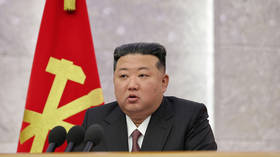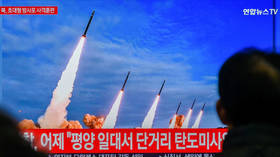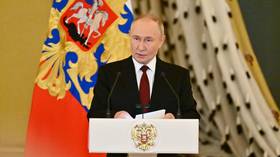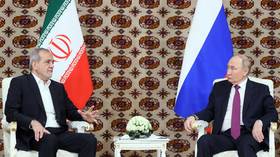A series of events and speculation has stirred debate over what’s happening on the Korean Peninsula
A series of coinciding events has prompted alarmists and incompetent experts to state that “the Korean Peninsula is on the brink of war.” While there is always a possibility that any incident may escalate into an armed conflict, and the risk is never either zero or 100%, at this point there is no need for undue concern. Below, we will discuss the incidents – which, taken together, may indeed disturb anyone who is less familiar with the complexities of the situation in Korea – in more detail.
South Korean drones over Pyongyang
The current tensions, characterized by an exchange of mutual threats along the lines of “Don’t you dare, or you’ll face dire consequences” were triggered by South Korean drones dropping anti-North Korea leaflets over Pyongyang. This incident was confirmed by Russian Ambassador to North Korea Aleksandr Matsegora, and photos suggest these were plane-like UAVs similar to South Korean models.
It is well known that the propaganda war between North and South Korea frequently makes use of balloons. This tactic was initiated by South Korean “civil activists” who, for many years now, have been launching propaganda balloons with pamphlets, USB flash drives, etc., and sending them across the border. Apparently, former South Korean president Moon Jae-in and the incumbent, Yoon Suk-yeol, have permitted these activities, since the balloons are launched from state-controlled border areas. Following some harsh rhetoric from North Korea, the Democratic government in Seoul imposed a ban on launching balloons, but with the return to power of conservative forces, the balloon campaigns resumed.
These initiatives can be quite dangerous, because the propaganda leaflets are not merely aimed at undermining North Korea’s “spiritual integrity” but intend to provoke an armed conflict between North and South Korea. The provocateurs assume that as an ideocratic state, North Korea cannot ignore insults to “its highest dignity”; in fact, this is similar to the propaganda leaflets distributed by Nazi Germany, calling on Russians to “beat the Jewish political commissioner.” Naturally, if North Korea resorts to a harsh military response (such as artillery strikes on balloon launch sites in South Korea), this would leave the South with no choice but to retaliate, thereby igniting the kind of conflict that apocalyptic Protestant sects in South Korea are anticipating – a crusade of Christianity and democracy against godless communism. In the eyes of such pastors, Koreans are the chosen people whose sacrifice will ensure victory.
However, despite the fierce rhetoric, North Korea has come up with some impressive countermeasures. In retaliation for the propaganda balloons, they loaded their own balloons with trash and sent them back to South Korea. These balloons carry household waste and paper scraps. To date, North Korea has launched over 6,000 trash balloons, some of which even landed in the presidential compound in Seoul. Although there has been some damage from these balloons, thankfully, no casualties have been reported. This response seems far preferable to bombings. The balloons are launched in response to anti-North Korea propaganda broadcast through loudspeakers in border areas, although I personally believe it would be more fun to drown out K-pop with traditional Korean music or the Moranbong Band girl group – the “Pyongyang response to Vanessa Mae.”
Provocateurs, however, clearly disapprove of such a solution, and apparently someone has decided to escalate tensions. From an international law perspective, launching drones is a far more serious violation of airspace and national sovereignty than sending balloons that drift with the wind. Moreover, South Korea’s reaction to these events is quite intriguing. Organizations that are usually involved in sending balloons with leaflets said that they had nothing to do with it. Initially, South Korean military officials denied involvement, but their stance later shifted to “We cannot either confirm or deny what North Korea is claiming.” Furthermore, the authorities declined to investigate who was behind the drone launches, while Kim Yo-jong, the deputy department director of the Publicity and Information Department of the Workers’ Party of Korea and the sister of North Korea’s supreme leader, Kim Jong-un, directly accused the South Korean military of provocation.
This gives reason to speculate that the drones entered North Korean airspace without the approval of the country’s military leadership. This means that in the South Korean military, there is perhaps a group of “young radicals” who either wanted to showcase Seoul’s military capabilities to Pyongyang or settle scores for past incidents when North Korean reconnaissance drones successfully flew to South Korea and back, unnoticed by its missile defense systems. A more troubling scenario arises if this group is linked to the aforementioned Protestant sects, since this may result in further provocations.
Meanwhile, North Korea has ordered its artillery forces located along the border to full combat readiness, and launched a nationwide campaign encouraging enlistment in the Korean People’s Army. While this is a significant escalation, no new provocations have occurred as of yet. Hopefully, tensions will gradually ease, leading to a situation on the Korean Peninsula reminiscent of the Cold War standoff between the Soviet Union and the United States. We might see an arms race, occasional displays of power, and minor incidents, but it seems unlikely that either side will cross the red lines. After all, from a tactical perspective, should conflict arise, both parties would likely inflict major damage on each other.
One can only hope that, although “foolish grassroots initiatives” are seldom acknowledged by the command, the military will conduct an internal investigation and rein in the reckless enthusiasts whose actions could jeopardize the entire country. After all, a similar situation occurred in 2010 when South Korean forces shelled North Korean territorial waters during exercises near the border, assuming that since nobody was harmed other than fish, they would face no consequences. However, in response, North Korea bombarded Yeonpyeong Island, which resulted in four deaths. The conflict did not escalate further only because all parties understood the underlying reasons.
Cut-off roads to South Korea
The fact that North Korea has positioned its artillery units along the border has coincided with another major event: its forces have blown up roads leading toward the border with South Korea, cutting off any remaining communication routes between the countries.
This marked the culmination of a series of defensive measures undertaken by North Korea following the radical shift in its inter-Korean policy in late 2023-early 2024, when it abandoned the concept of reunification. When the country first became divided, many believed that Korean reunification would eventually happen. Up until 1972, Pyongyang considered Seoul its capital, labeling it as “temporarily occupied” territory. While discussions of reunification in the early 20th century were often framed as a distant prospect, the “Olympic thaw” of 2018-2019 revealed that even under the relatively liberal administration of former President Moon, Seoul viewed inter-Korean dialogue as more of a ceremony than a real cooperation opportunity. However, under conservative leadership, South Korea’s stance toward North Korea became overtly hostile, and Pyongyang realized that the idea of a hypothetical reunification with its “compatriots” in the South resembled the once widespread notion that the German people wouldn’t fight for the Nazis.

It is now officially acknowledged that two antagonistic states exist on the Korean Peninsula, and South Korea is openly referred to as an enemy. However, the idea of waging war for the sake of forcible reunification is no longer relevant. North Korean propaganda asserts that if South Korea initiates the conflict, it will inevitably be crushed and its territory will be absorbed by the North – but this may happen only in response to aggression. Being prepared for war isn’t the same as wishing to initiate a war; moreover, Pyongyang fully understands that due to the Mutual Defense Treaty signed in 1953 between the US and South Korea, any conflict would immediately escalate into a confrontation involving North Korea, the US, and their allies. This is why, since the beginning of the year, North Korea has been preparing to defend itself in case of a South Korean offensive and has been constructing minefields and fortifications. The destruction of roads underscores this doctrine, and here, one point should be clear to military experts.
When a country prepares for an offensive, it seeks to establish a robust system of communication lines crucial for providing cross-border support for the attacking forces, including reinforcements and ammunition. This aspect often comes up in discussions about the outbreak of the Korean War – military historians note that North Korean tanks were largely destroyed by US airpower rather than mines. This can be explained by the fact that although South Korea also prepared to attack the North, the latter’s military leadership was able to secure approval for an offensive operation, while South Korea’s military did not get such approval.
The idea that blowing up roads is yet another “provocation” by North Korea sounds amusing, especially considering the fact that South Korea’s Constitution states that the country’s territory encompasses the entire Korean Peninsula, while its National Security Act defines North Korea not as a state but as an anti-state entity that has illegally occupied the northern provinces. This is quite similar to how Kiev perceived Donetsk and Lugansk when they were still unrecognized republics. However, despite the striking images of blown-up roads, the fact that North Korea prepares to defend itself actually means that most likely, it will not initiate the conflict.
Ratification of the Treaty on Comprehensive Strategic Partnership between Russia and North Korea
In my view, this document should have been ratified much earlier. However, considering the slow bureaucratic processes, the fact that Russian President Vladimir Putin proposed to ratify the document at this precise time seems more of a coincidence than a deliberate display of Russia’s support for Pyongyang. Moreover, this treaty is a move that is more likely to ease tensions on the peninsula rather than escalate them.
Western analysts, along with some others, have focused on Article Four of the agreement, which states that if one party finds itself in a state of war, the other is obligated to provide all possible military assistance. In the West, this has been interpreted as an indication that North Korean troops might soon be deployed to Ukraine or that, backed by Moscow, Pyongyang could engage in new armed provocations.
However, the wording “state of war” is crucial. Not every armed conflict qualifies as “war,” and technically speaking, Russia’s special military operation is not considered such. Thus, it may be more important to focus on Article Three of the agreement, which states that the parties must hold consultations and develop joint strategies in the event of a potential conflict. Given the history of cooperation between Moscow and Pyongyang in this area, these consultations are likely aimed at seeking non-aggressive solutions to the problem, since another flashpoint close to Russia’s borders would be undesirable for Moscow.

Additionally, the fact that both North and South Korea are bound by mutual defense agreements with major world powers transforms the conflict into a macro-regional issue. The prospect of a third world war is unfavorable for both Washington and Moscow, as the losses far outweigh any hypothetical gains.
Some Western experts and Russian liberals believe that the ratification of this agreement will lead to a significant cooling of relations between Moscow and Seoul, and may lead Russia to lift the international sanctions imposed on Pyongyang by the UN Security Council. These fears appear to be exaggerated. Article Five of the agreement indeed prohibits the parties from engaging in hostile actions, so South Korean pastors will no longer be able to deliver lectures in Russian universities about the alleged atrocities committed by North Korea, or state that communism is an extension of satanism. However, this article does not affect other ties between Russia and South Korea; and although it could impact military-technical cooperation, currently such cooperation is nonexistent.
As for the sanctions, it appears that for now, Russia’s position remains unchanged. Indeed, top Russian officials frequently say that the sanctions regime against North Korea is unjust and should be revised. And Russia is firmly opposed to imposing new sanctions on North Korea under any pretext, given that the overall level of sanctions pressure is already close to a total economic blockade. It’s also true that the interpretation of sanction documents has become more creative, along the lines of “what is not forbidden is allowed,” and in some cases this may look like finding legal loopholes to circumvent sanctions. Nevertheless, there has been no open disregard for the international sanctions that Russia itself has once voted for.
Theoretically, this could change in the context of an ongoing “global turbulence,” characterized by the disintegration or diminished significance of structures and institutions associated with the old world order (including the authority of the UN and the doctrine of nuclear non-proliferation) or due to unforeseen circumstances on the Korean peninsula. But the time for this hasn’t come yet.
Turning back to the relationship between Moscow and Seoul, South Korea remains “the friendliest of unfriendly countries” for Russia. Although verbal spats and diplomatic tensions occasionally flare up, both sides seem more inclined to maintain their current level of cooperation rather than dramatically sever ties. The red line is clearly defined: for Moscow, it is the direct supply of weapons and military equipment to Ukraine; for Seoul, it is the military-technical cooperation between Russia and North Korea that would boost North Korea’s missile and nuclear capabilities. The trend towards maintaining contact is evident from the ongoing humanitarian cooperation between the two countries. This is an important indicator, since the humanitarian sphere is first to suffer when tensions arise.

Zelensky’s claims about North Korean troops in Ukraine
Frankly speaking, the story about “thousands of North Korean special forces troops disguised as Buryats” was first made up by the author of this article over a year ago. At that time, I got a call from some scammers who asked me if I knew that my granddaughter had withdrawn 800,000 rubles from my bank account. They claimed that this money might have been stolen and demanded my bank account details and the keys to the apartment. However, my improvised response took them by surprise: you see, I told them, my granddaughter is studying to become a military translator and is secretly accompanying a unit of North Korean special forces troops which is about to be sent to the zone of Russia’s special military operation. But some logistical issues have come up. North Korean soldiers are used to eating dogs, but if they start catching and eating them in Ukraine, they’ll reveal themselves. So the dogs have to be bought and transported at my own expense, and there’s nothing criminal about this money being withdrawn from my bank account for that very purpose. Apparently, though, my little prank has gone out of control.
The first reports claiming that a group of North Korean servicemen had been eliminated in Ukraine, or that units of the Korean People’s Army were being redeployed to Ukraine, appeared in Ukrainian media – mostly tabloids rather than official publications. These articles either referenced “anonymous sources in the intelligence community” (journalists know such sources exist only in the author’s head) or “Russian social media” – an intriguing reference to some particular Telegram channels. These are either outright pranksters or Ukrainian/pro-Ukrainian channels which even anti-Putin channels consider “cringe content.” On those channels, posts about invaders from North Korea are seen next to “leaked information” about how Putin secretly visited underground druids in Chukotka and, after sacrificing a black seal, divined whether to use tactical nuclear weapons in Ukraine.
However, tales like these have found their way into modern Ukrainian propaganda. Although I am neither an expert on Ukraine nor a military analyst, it seems clear that Zelensky’s regime urgently needs further justification for more Western aid, and it also needs to explain to the public why the situation on the front lines is so dire. In this context, North Korean troops serve as a mythical monster summoned by enemies from the depths of the underworld – a new monstrous threat against which old measures are ineffective and new solutions are desperately required. Meanwhile, evidence of North Korean military presence in Ukraine boils down to either hearsay – e.g., “a friend of a friend told me” – or grainy videos captured from behind a fence, showing unidentified people in uniforms carrying who knows what (supposedly dogs) who knows where. However, in the context of wartime propaganda, some consider this sufficient evidence. After all, arguments like “here’s a satellite image showing train cars, and I solemnly swear they’re loaded with North Korean missiles” have met with relative success.
Interestingly, the South Korean leadership earnestly considers this possibility. Such concerns were first raised by South Korea’s minister of defense: If Moscow and Pyongyang have formed a military alliance, why wouldn’t they help each other? Then, the National Intelligence Service of South Korea, eager to please the higher-ups, picked up the story and presented analysis and satellite images, prompting the country’s leadership to discuss the matter. However, the situation remains stuck at the stage of “monitoring developments and expressing regret over potential outcomes.”

Meanwhile, I believe that the hypothetical presence of North Korean troops in Ukraine would bring more problems than benefits, since I do not buy the Western narrative that the situation is so bleak for Russia that only pseudo-Buryats can save its military campaign. Firstly, given the tensions on the Korean Peninsula, it is unlikely that North Korea would deploy substantial forces far from home. Secondly, the arrival of these troops would indeed present certain challenges, particularly regarding the number of military interpreters needed to ensure communication at various levels – from high command to everyday interactions. Thirdly, the internationalization of the conflict would also create similar opportunities for the other side – NATO could easily establish its presence in Ukraine in the same way, even if we’re talking about “volunteers.” Finally, the use of North Korean forces could impact Russia’s domestic political landscape, potentially harming the ruling party’s ratings, since people would raise questions like, “Can’t the Kremlin resolve this internal issue on its own, without such allies?” Despite a decreasing number of myths about North Korea in the Russian media, many Russians still perceive North Korea as a bizarre place where listening to K-pop could get you sentenced to death by flak cannon.
In conclusion, while the world is shaken by global turbulence, anything can happen. However, speculating that the Korean Peninsula is on the brink of war is akin to “survivorship bias.” If any conflict or incident were to occur, most likely it would not be the result of actions undertaken by the leadership of either country, but would be caused by irrational factors, including provocations by third parties.
In one video where North Korean troops were seen running around and shooting, the watermark of a North Korean media outlet appeared on the screen. However, this media outlet was shut down over six months ago when North Korea closed down media aimed at South Korean audiences due to a shift in its communications strategy. So it’s no wonder that while Kiev has little doubt about the presence of North Korean troops in Ukraine and Seoul weighs this possibility (South Korea’s top leadership has not confirmed it), as of October 17, 2024, the US Department of Defense has stated that it cannot confirm this information.




